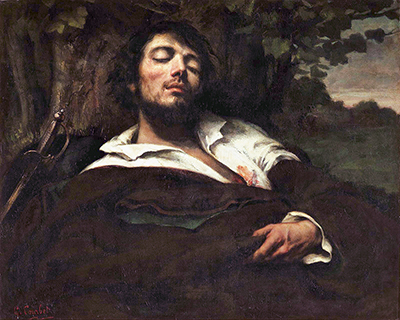The Wounded Man is loosely dated at between 1844 to 1854 and continues this somewhat arrogant artist's self-obsessive streak. Whatever his character, Gustave Courbet was a supreme artist who required a strong personality in order to continue along his route of promoting the merits of the Realism art movement.
Courbet famously described how he saw his series of self-portraits as a diary of his life. He always created a new one whenever he felt his mood had changed and he revisited this genre throughout his career, leaving behind a stunning portrayal of his life in visual form. The reason for the wide range of date on this painting is that it was initially completed in 1844 but Courbet then revisited it around a decade later in order to make considerable adjustments. There was originally a woman alongside the artist but he later removed her, suggesting the breakdown of a close relationship. In her place he added a sword. The original artwork can now be found at the Musée d'Orsay, as part of a collection of over 40 of the artist's paintings.
Across art history swords and blood have often been included within paintings to symbolise brushes and paint. An artist as emotional as Courbet could easily make this comparison, feeling such passion for his work as he did. A further connection was discovered in the letter 'C' that was added to the sword, drawing a further connection to the artist himself. Several drawings have been uncovered which outline how the painting was originally planned, with the artist in a touching embrace with a young women - presumably a lover at that time who he later fell out with.
There were many other notable self-portraits from Courbet's career, with some of the highlights including the likes of The Desperate Man, The Meeting and Self-Portrait with a Black Dog. Beyond that, there were many more contributions to this genre during his career as this self-reflecting painter continued to enter his own mind for inspiration to produce new paintings. Courbet was one of a number of famous artists who continually depicted themselves and found a great interest in capturing their own complex thoughts. Rembrandt made a career from doing so, even though he prefered to work within other genres. Others such as Diego Velazquez worked more subtly, such as with his Las Meninas.




